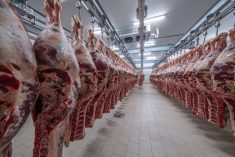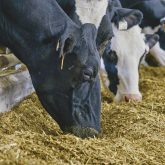Animal welfare advocates call Canada’s new code of practice for the care and handling of pigs — which commits farmers who follow it to adopt group housing for sows in any new barns built after July this year — a “watershed moment” for the industry.
The revised code, replacing the previous version released in 1993, also proposes to phase in other new requirements for hog barns and pens — and for pain control for procedures such as castration and tail docking — and urges producers to reconsider other practices such as teeth clipping in piglets.
Read Also

Ample supplies and improved livestock sector to boost Canadian feed sector: FCC
Abundant feed grain supplies and improved profitability for the livestock sector should support strong feed demand and sales through the winter, says a new report from Farm Credit Canada.
The new code, released Thursday after three years of consultations and two months of public comment, is “a step that recognizes the healthy and rigorous debate of a diverse group of stakeholders to constructively address pig welfare in Canada,” Florian Possberg, the Humboldt, Sask. hog producer who chaired the code development committee, said in a release. [Related story]
Codes of practice — nationally developed guidelines for the care and handling of farm animals — are in place for virtually all farmed animal species, and serve as “our national understanding of animal care requirements and recommended practices,” the code’s authors explained.
In the hog sector’s case, the new code is expected to guide a pending review and update of the Canadian Pork Council’s Animal Care Assessment (ACA) program — which, since 2012, has been a requirement for producers taking part in the hog industry’s Canadian Quality Assurance (CQA) program.
CPC chairman Jean-Guy Vincent on Thursday hailed the new code as “a source of tremendous pride” and representing “our commitment to the animals in our care, the sustainability of our industry, our ability to work collaboratively with a diverse stakeholder group and the leadership we provide to a global industry.”
“We are fully committed to the adoption of group-housing systems for our sows and gilts in all new constructions,” Rick Bergmann, vice-chairman of Manitoba Pork, added in a separate release. “The updated Code will provide strategy and guidance for the adoption of group housing that will ensure best animal care outcomes.” [Related story]
“Still much needed”
Barbara Cartwright, CEO of the Canadian Federation of Humane Societies (CFHS), and Sayara Thurston, campaign manager for Humane Society International/Canada, each called the new code a “watershed moment” for Canada in separate releases Thursday.
“It signals the beginning of the end of archaic, extreme confinement systems that consumers simply don’t support and which other countries have long since banned,” Thurston said. “There is still much advancement needed to improve the welfare of pigs raised on Canadian farms, but this code of practice is a monumental first step.”
CFHS is “disappointed that the pig industry wasn’t willing to outright end the use of inhumane sow stalls,” Cartwright said, but added that retailers and consumers are now “pushing the market hard to completely eliminate gestation stalls,” noting pledges by companies such as Tim Hortons, Loblaw, McDonald’s and Costco to phase out sow stall use among their pork suppliers.
Gestation stalls are individual housing crates used by some hog breeding operations for sows during pregnancy, meant to reduce the risk of aggressive behaviours seen between pregnant sows in group housing, and to allow for more precise individual feeding of sows.
The National Farm Animal Care Council, which oversaw development of the code with funding support from the federal ag department, “takes an engagement- and science-driven approach to improve farm animal care in Canada,” Scott Bonikowsky, vice-president of corporate affairs for Tim Hortons, said in a separate release.
With the new code, he added, “we believe NFACC has made a considerable step forward for the welfare of pigs.”
Housing
Among the updated code’s requirements, any new or renovated barns brought into use for the first time after July 1 this year will require mated gilts and sows to be housed in groups. Individual stalls can be used for up to 28 days after the date of last breeding, and for seven more days when needed to manage grouping.
New and replacement individual stalls set up after July 1 must be “sized appropriately” so sows can stand up at rest without touching both sides at the same time, stand without touching both ends at the same time, stand without touching the top bars and lie down without udders “protruding into adjacent stalls.”
As of July 1, 2024, mated gilts and sows generally must be housed in groups or in individual pens, or in stalls following the new code requirements but only if sows “are provided with the opportunity to turn around or exercise periodically, or other means that allow greater freedom of movement.” To that end, the new code calls for industry stakeholders to come up with “suitable options” by July 1, 2019.
Similar requirements and deadlines are laid out for housing boars; the code notes boars “must be able to stand, lie down and adopt normal resting postures without undue interference.”
For farrowing crates, in which sows give birth and nurse young piglets, the length of the crate “must allow the sow enough room to move forward and backward, and to lie down unhindered by a raised trough or rear gate,” and “must provide an area to which the piglets can retreat when the sow moves.”
When standing in a normal position in a farrowing crate, a sow must not touch both sides of gthe crate (not including anti-crush rails) at the same time, and her back must not touch any bars along the top.
Sows must not be kept in farrowing crates for more than six weeks in any one reproductive cycle except in “exceptional circumstances,” such as when a sow is used to foster a second litter.
The code also lays out formulae for general space allowances per animal in hog pens, and allows for short-term decreases in space where needed at the end of a production phase, reducing area by up to 15 per cent for nursery pigs and up to 10 per cent for grower/finisher pigs.
In a tighter space crunch, the area per hog could be reduced slightly more if it can be shown higher densities “do not compromise the welfare of the animals as determined by average daily gain, mortality, morbidity and treatment records” and “vices such as tail-biting” don’t increase or develop in the pen.
Each hog barn, the new code added, “must have the ability to segregate sick or injured pigs in a separate area where the necessary treatment can be administered.”
The code also calls for “sufficient lighting” in barns for thorough inspections and “normal husbandry,” and for farmers to provide at least 50 lux of lighting for at least eight hours per day. It also calls for hogs to have daily access to darkened areas (except for pigs that have just been weaned in the past 48 hours, or for piglets under heat lamps) for at least six consecutive hours. (As a guideline, 50 lux is bright enough for a person with “normal” sight to read standard-size newspaper print.)
Husbandry, handling
The new hog code immediately requires any castrations done on males over 10 days old to be done with anesthetic and analgesic to help control pain. Starting July 1, 2016, that rule will expand to castrations performed on swine at any age.
Similarly, the new code immediately required pain control for tail docking done on pigs over seven days old, and expands that rule starting July 1, 2016 to require analgesics when tail docking is done on swine at any age.
The code also urges routine monitoring for signs of tail-biting and “corrective action” where needed, such as to fix possible contributing factors, remove a tail-biter or add rooting and/or more “physical enrichment” in a pen.
(The new code also says pigs must be provided with “multiple forms of enrichment” meant to improve welfare through “enhancement of their physical and social environments.”)
The need to clip piglets’ teeth “must be evaluated, and the procedure performed only when deemed necessary,” the new code said. Routine teeth clipping — done on piglets to reduce injury to littermates and/or a sow from “needle” teeth — is “less common” today and can cause discomfort or infections when done improperly, the code noted.
The code also weighs in on the practice of ear notching to identify breeding animals, saying the practice is “considered to be painful,” while other methods, such as ear tattoos, cause stress in pigs but that can be managed through “refinement of equipment and techniques.”
Ear notching, the new code said, “must only be performed on piglets when deemed necessary and when piglets are less than 14 days of age.”
The code also aims to limit use of electric prods as a “last resort and never as the primary driving device” in handling hogs, as opposed to “humane” toold such as chase boards and shakers.
If needed, electric prods should only be used on a lead hog’s back and hind quarters and never in the anal and genital areas — and only when there is a clear path for a hog to move forward. Electric prods also must not be used in the finishing pen, nor on piglets, nor nursery, distressed, sick or injured pigs, the code said.
Pigs also “must not be tethered as part of their normal housing systems,” according to the new code, which also prohibits the use of nose rings in hogs. — AGCanada.com Network
















